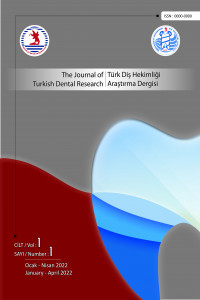Tek Taraflı Arka Çapraz Kapanışa Sahip Çocuklarda Yumuşak Doku Burun Deliği Genişliğinin Değerlendirilmesi
Çapraz kapanış, Maksiller transversal darlık, Burun deliği genişliği
Evaluation of Soft Tissue Nostril Width in Children with Unilateral Posterior Crossbite
Cross bite, Maxillary transversal deficiency, Nostril width,
___
- 1. Proffit WR. Fields HW. Sarver DM. Concepts of Growth and Development. In: Profitt WR, editor. Contemprary Orthodontics. 5th ed. Elsevier Health Sciences, 2014;20- 66.
- 2. Björk A, Skieller V. Growth of the maxilla in three dimensions as revealed radiographically by the implant method. Br J Orthod.1977 Apr;4(2):53-64. doi: 10.1179/bjo.4.2.53.
- 3. McNamara A, James A. Maxillary transverse deficiency. Am J Orthod Dentofacial Orthop. 2000 May;117(5):567-70.doi: 10.1016/s0889-5406(00)70202-2.
- 4. Altug-Atac AT, Atac MS, Kurt G, Karasud HA. Changes in nasal structures following orthopedic and surgically assisted rapid maxillary expansion. Int J Oral Maxillofac Surg. 2010 Feb;39(2):129-35.
- 5. Laptook T. Conductive hearing loss and rapid maxillary expansion: report of a case. Am J Orthod. 1981 Sep;80(3):325-31. doi: 10.1016/0002-9416(81)90294-3.
- 6. Kurol J. Impacted and ankylosed teeth: Why, when, and how to intervene. Am J Orthod Dentofacial Orthop. 2006 Apr;129(4 Suppl):S86-90.doi: 10.1016/j.ajodo.2005.11.008.
- 7. Halazonetis DJ. Morphometric evaluation of soft-tissue profile shape. Am J Orthod Dentofacial Orthop. 2007 Apr;131(4):481-9. doi: 10.1016/j.ajodo.2005.06.031.
- 8. Primozic J, Perinetti G, Contardo L, Ovsenik M. Facial soft tissue changes during the pre-pubertal and pubertal growth phase: a mixed longitudinal laser-scanning study. Eur J Orthod. 2017 Feb;39(1):52-60.doi: 10.1093/ejo/cjw008. Epub 2016 Feb 17.
- 9. Meneghini F. Views of Clinical Facial Photography. Clinical facial analysis: elements, principles, and techniques. Springer Science & Business Media. 2012;23- 32.
- 10. Djordjevic J, Zhurov AI, Richmond S, Consortium V. Genetic and Environmental Contributions tom Facial Morphological Variation: A 3D Population-Based Twin Study. PloS ONE 11(9): e0162250. doi:10.1371.
- 11. Baydaş B, Erdem A, Yavuz I, Ceylan I. Heritability of facial proportions and soft-tissue profile characteristics in Turkish Anatolian siblings. Am J Orthod Dentofacial Orthop. 2007 Apr;131(4):504-9. doi: 10.1016/j.ajodo.2005.05.055.
- 12. Fabiana B, Alberto B, Salvatore R, Alessandro N, Paola C. Is there a correlation between nasal septum deviation and maxillary transversal deficiency? A retrospective study on prepubertal subjects. Int J Pediatr Otorhinolaryngol. 2016 Apr;83:109-12. doi: 10.1016/j.ijporl.2016.01.036.
- 13. Sollenius O, Golež A, Primožič J, Ovsenik M, Bondemark L, Petrén S. Three-dimensional evaluation of forced unilateral posterior crossbite correction in the mixed dentition: a randomized controlled trial. Eur J Orthod. 2020 Sep 11;42(4):415-425.doi: 10.1093/ejo/cjz054.
- 14. Torun GS. Soft tissue changes in the orofacial region after rapid maxillary expansion : A cone beam computed tomography study. J Orofac Orthop. 2017 May;78(3):193-200. doi: 10.1007/s00056-016-0074-9.
- 15. Metzler P, Geiger EJ, Chang CC, Steinbacher DM. Surgically assisted maxillary expansion imparts three-dimensional nasal change. J Oral Maxillofac Surg. 2014 Oct;72(10):2005-14. doi: 10.1016/j.joms.
- 16. Magnusson A, Bjerklin K, Kim H, Nilsson P, Marcusson A. Three-dimensional computed tomographic analysis of changes to the external features of the nose after surgically assisted rapid maxillary expansion and orthodontic treatment: a prospective longitudinal study. Am J Orthod Dentofacial Orthop. 2013 Sep;144(3):404-13. doi: 10.1016/j.ajodo.2013.04.013.
- 17. Karabiber G, Yılmaz HN.Does unilateral surgically assisted rapid maxillary expansion (SARME) lead to perinasal asymmetry? J Orofac Orthop. 2021 Aug 6.doi: 10.1007/s00056-021-00333-y.
- Başlangıç: 2022
- Yayıncı: Ondokuz Mayıs Üniversitesi
Sabahat YAZICIOĞLU, Yeşim ÜNLÜBAŞ, Murat TÜREDİ
Yaşlılıkta Temporomandibuler Eklemde Görülen Değişiklikler
Zerrin ÜNAL ERZURUMLU, Peruze ÇELENK
Dental Kaynaklı Ekstraoral Fistülün Endodontik Tedavisi: Bir Olgu Sunumu
Özgür Soysal ÖZDEMİR, Burcu PİRİMOGLU
Amir Masoud BOZORGİ, Feyza OTAN ÖZDEN
